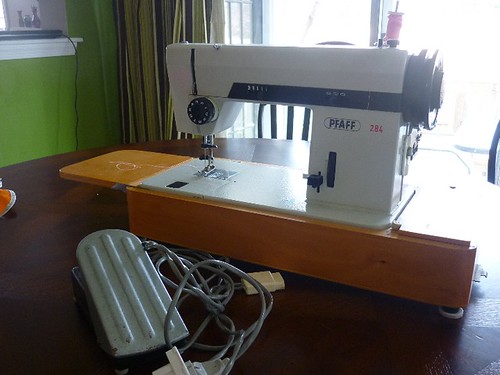So... you guys know I like sewing machines, right? And I already posted about one of the cases and antique machines that I restored here. But that was just ONE of... um... the COMPLETELY REASONABLE number of sewing machines that I have. I can tell it's a reasonable number because my husband still lets me buy them without rolling his eyes even a little. I return the favor when he decides he just HAS to order expensive industrial (like crop-dusting) strength herbicides that are only available on the internet.
The really nice thing about collecting old sewing machines is just how devalued they tend to be on the presumed basis that practically no one sews anymore, and those who do buy fancy Janome or Huskavarna machines with a million stitches built in and an automatic threader. Which is not to say that modern machines aren't great, but they are mostly made of plastic and I've ruined an expensive newer machine with some of the crazy things I choose to sew.
For a long time my sewing machine Holy Grail was to find a Pfaff sewing machine. I'd read blogs and heard people talk about what nice stitching they do, how they are powerhouses and aren't phased by the thickest seams or material. How they last forever and are basically the most awesome thing ever to come out of West Germany. But it's hard to find the old, mostly-metal mid-century models because they now belong to little old ladies who are NOT giving them up. Fortunately for me one day we were at a thrift store and my husband came over and asked, "What's that sewing machine brand you're always looking for? Something with a 'P'?" And then he showed it to me! The beautiful, perfect, Pfaff 284 that became mine for only $25!!
 |
| I stole this photo from the internet. |
That is not my Pfaff, but it did look just like that after I cleaned it up and oiled it. Unfortunately, my machine didn't come in a pretty wooden case like that. It came in a broken press-board base that snagged every piece of fabric in its immediate vicinity. So for a long time I'd wanted to give it a proper home where I could use it without having to either leave it in the scratchy box or take it out and worry about the bottom of it destroying my desk. Good thing I hoard have other sewing machines!
I picked this table up at another thrift store for $15. It contained a pretty neat in its own right vintage White 468 that was made in Japan.
 |
| That's the box that the Pfaff came in. |
The thing I liked about the table was how it had simple lines that seemed appropriate for the stark, German Pfaff styling. The thing I didn't like was that the finish was orange-y and all scratched up.
 |
| Lookin' a little rough there, pal. |
 |
| Don't worry! I will help you!! |
So I took the thing all apart and promptly let it sit in the basement for five months. What? I'VE BEEN BUSY! A couple of weeks ago I finally had some free time to start working on it. Unlike other sewing machine cases I've refreshed, this one actually had decent wood that wasn't chipping or ruined with peeling veneer. Step one was to strip off the old finish which I did with chemical stripper. Then I sanded it with 150 grit sandpaper, followed by 220, and then 0000 steel wool. Once it was nice and smooth, I was ready to stain.
I wanted it somewhat dark, so I did two coats of Minwax Wood Stain in Dark Walnut. After that dried, I covered everything in three coats of polyurethane, sanding with 320 grit sandpaper between coats.
 |
| And voila! |
It could be styled as a cute side table when not in use.
But with this beauty inside, what are the odds it won't get used?
Fun fact: if someone at Lowe's asks if you need help, you will waste a lot of time if you ask him whether or not they used the metric system in post-Soviet West Germany. They did. Metric all the way. There was only one of the original set screws that hold the machine onto the brackets in the case, so I had to get another. Unfortunately they only had M6-1.00 pan head screws at Lowe's, which wouldn't fit due to the head. So the next day we had to go to Home Depot for proper set screws. Whereupon we returned home and I realized that we don't own a metric hex-wrench set. *SIGH* Luckily we had a star-head bit from one of our various bit-driver sets that was close enough to get the job done.
 |
| TA-DA! |



You sure inspire me. Now I know why my refinishing never looks that good. The secret is 0000 steel wool and lightly sanding between coats of poly. Except I've rarely put two coats of poly on anything:)
ReplyDeleteIt's amazing what a difference sanding between coats makes. I only started doing that (i.e. the right way) a couple of projects ago and it's definitely worth the effort.
DeleteThis comment has been removed by the author.
ReplyDelete